
Revelation 11
15 Then the seventh angel blew his trumpet, and there were loud voices in heaven, saying, “The kingdom of the world has become the kingdom of our Lord and of his Christ, and he shall reign forever and ever.” 16 And the twenty-four elders who sit on their thrones before God fell on their faces and worshiped God, 17 saying, “We give thanks to you, Lord God Almighty, who is and who was, for you have taken your great power and begun to reign. 18 The nations raged, but your wrath came, and the time for the dead to be judged, and for rewarding your servants, the prophets and saints, and those who fear your name, both small and great, and for destroying the destroyers of the earth.” 19 Then God’s temple in heaven was opened, and the ark of his covenant was seen within his temple. There were flashes of lightning, rumblings, peals of thunder, an earthquake, and heavy hail.
Can we live without hope?
The great Greek writer Nikos Kazantzakis struggled to understand life and death and what awaits us after death. He had a respect for Christianity but ultimately his unorthodox views got him excommunicated from the Greek Orthodox Church.
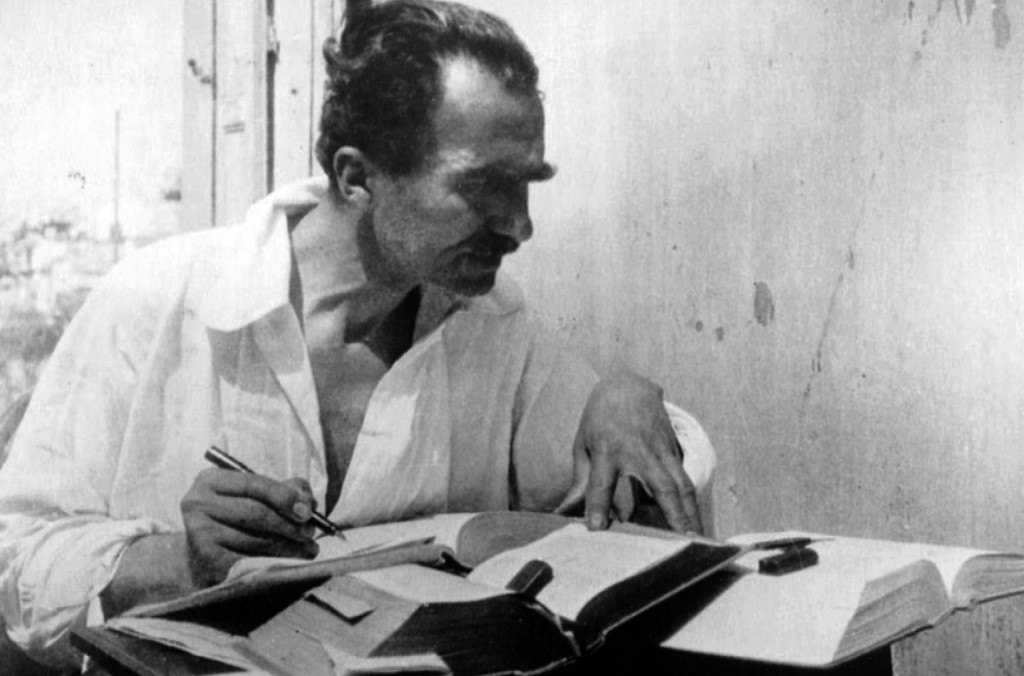
Tragically, Kazantzakis came to see hope as a negative thing. He wrote this about the meaning of life and how to live it:
We all ascend together, swept up by a mysterious and invisible urge. Where are we going? No one knows. Don’t ask, mount higher! Perhaps we are going nowhere, perhaps there is no one to pay us the rewarding wages of our lives. So much the better! For thus may we conquer the last, the greatest of all temptations—that of Hope.
Kazantzakis believe that man had certain duties in life. Kazantzakis’ first duty, in the words of John Messerly, is “to bravely accept our cognitive limitations” and the second is “to accept the heart’s anguish at being unable to find meaning in life.” But what of the third duty? Kazantzakis writes:
The moment is ripe: leave the heart and the mind behind you, go forward, take the third step. Free yourself from the simple complacency of the mind that thinks to put all things in order and hopes to subdue phenomena. Free yourself from the terror of the heart that seeks and hopes to find the essence of things. Conquer the last, the greatest temptation of all: Hope. This is the third duty.[1]
Kazantzakis’ most profound and tragic statement on hope came from his own hand but did not appear until after his death. I am talking about the inscription on his tombstone: “I hope for nothing. I fear nothing. I am free.”[2]
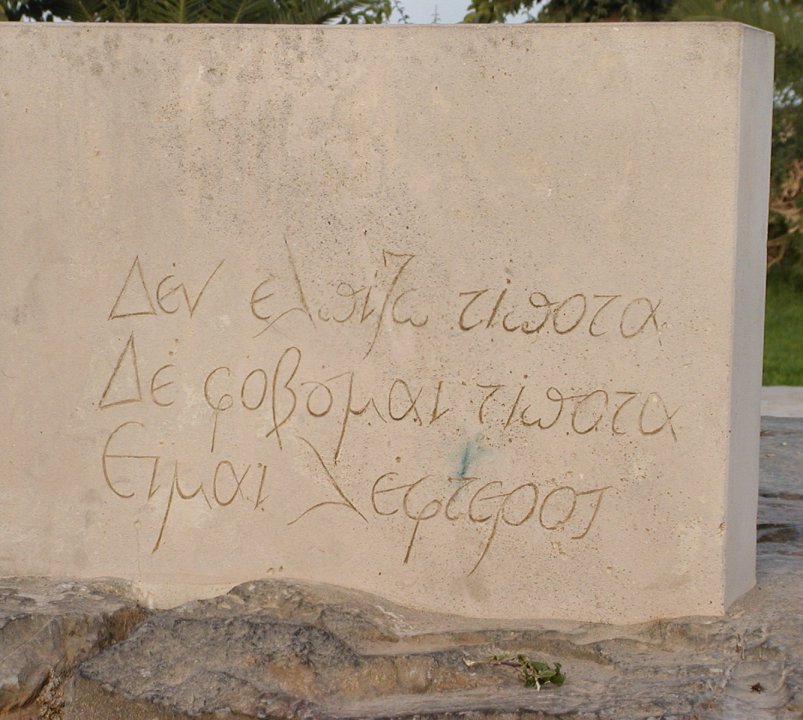
I am moved by the second statement: “I fear nothing.” I am inspired by the third statement: “I am free.” But I am positively chilled by the first statement: “I hope for nothing.” And what makes this first statement even sadder to me is that it is written on a tombstone that is itself standing beneath a cross.
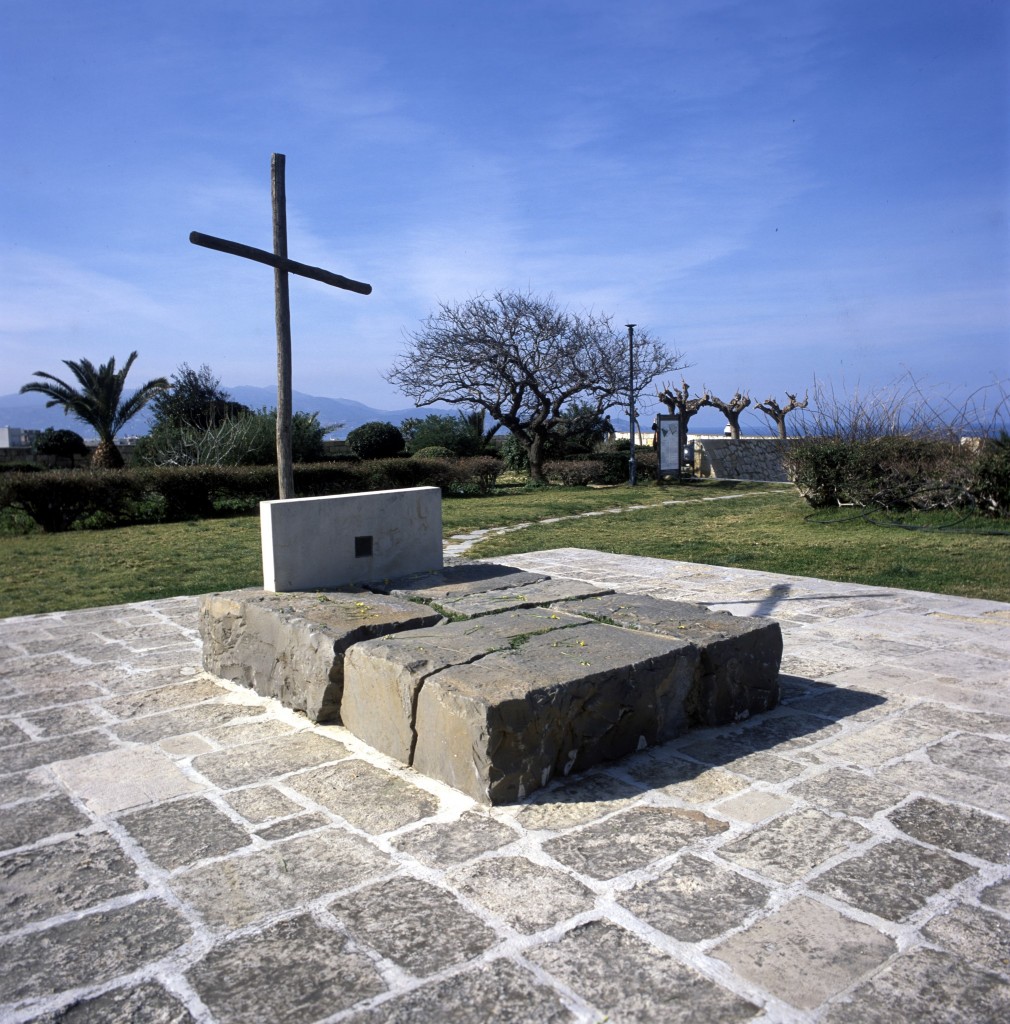
Why does this sadden me? Because the cross is humanities great hope! Because time and time and time again the Lord God in the scriptures and the Lord Jesus in the gospels and the witness of the New Testament at large offers us precisely this: hope. Hope! A reason not to despair. The certain knowledge that Jesus wins in the end and that all is not for nought.
I want to argue today that nowhere is the offer of hope more powerfully evident than in the book of Revelation. This will strike some as odd because they find Revelation frightening. I understand that. Parts of it are. But all throughout the book the Lord offers us time and time again the gift we most need: hope.
The Seventh Trumpet: A Glimpse of the Lamb’s Victory
We begin with the blowing of the seventh trumpet. The picture that emerges is one of victory.
15 Then the seventh angel blew his trumpet, and there were loud voices in heaven, saying, “The kingdom of the world has become the kingdom of our Lord and of his Christ, and he shall reign forever and ever.”
What a joy it is to see this amazing picture! “The kingdom of the world has become the kingdom of our Lord and of his Christ, and he shall reign forever and ever!” This is the picture of the end, by which we mean the beginning! This is the promised and coming and everlasting and unending reign of Christ. Once again we are in the throne room of heaven to see the response:
16 And the twenty-four elders who sit on their thrones before God fell on their faces and worshiped God, 17 saying, “We give thanks to you, Lord God Almighty, who is and who was, for you have taken your great power and begun to reign.
Here again we see the bitter/sweet message. Sweet, because Christ wins and reigns forever! But it is bitter for the objects of His wrath:
18 The nations raged, but your wrath came, and the time for the dead to be judged, and for rewarding your servants, the prophets and saints, and those who fear your name, both small and great, and for destroying the destroyers of the earth.”
What a picture! The wrath of God “destroys the destroyers of the earth.”
Then we are shown, surprisingly, the temple!
19 Then God’s temple in heaven was opened, and the ark of his covenant was seen within his temple. There were flashes of lightning, rumblings, peals of thunder, an earthquake, and heavy hail.
And, surprisingly again, we see the ark of the covenant! When last we saw it, it was placed in the Temple by Solomon in 2 Chronicles 5.
1 Thus all the work that Solomon did for the house of the Lord was finished. And Solomon brought in the things that David his father had dedicated, and stored the silver, the gold, and all the vessels in the treasuries of the house of God. 2 Then Solomon assembled the elders of Israel and all the heads of the tribes, the leaders of the fathers’ houses of the people of Israel, in Jerusalem, to bring up the ark of the covenant of the Lord out of the city of David, which is Zion. 3 And all the men of Israel assembled before the king at the feast that is in the seventh month. 4 And all the elders of Israel came, and the Levites took up the ark. 5 And they brought up the ark, the tent of meeting, and all the holy vessels that were in the tent; the Levitical priests brought them up. 6 And King Solomon and all the congregation of Israel, who had assembled before him, were before the ark, sacrificing so many sheep and oxen that they could not be counted or numbered. 7 Then the priests brought the ark of the covenant of the Lord to its place, in the inner sanctuary of the house, in the Most Holy Place, underneath the wings of the cherubim. 8 The cherubim spread out their wings over the place of the ark, so that the cherubim made a covering above the ark and its poles. 9 And the poles were so long that the ends of the poles were seen from the Holy Place before the inner sanctuary, but they could not be seen from outside. And they are there to this day.
But now it is open for us! Now we are allowed to see it! The ark is a symbol of the presence and victory of God. It is fitting that it is here. He inspires us with hope and with joy! The seventh trumpet shows us life with God in glory. It shows us the end. It shows us the victory of Christ. It is a picture of hope in the midst of a dark pictures of judgment and pain.
The Sevens: The Repetition of Hope
But it is not merely one picture of hope in the midst of a tapestry of judgment and suffering. No, the seventh trumpet in fact takes its place alongside both the seventh seal (that we have already seen opened) and the seventh bowl (that we are yet to see) in showing us a picture of hope and of joy.
To understand this we need to understand how interpreters of Revelation have differed in their understanding of the three sevens that dominate the book:
- seven seals
- seven trumpets
- seven bowls
Some people see these three sevens as three picture of the same reality or three looks at one reality from three different angles. These people stack the three sevens like pancakes, we might say, and view each of them as the whole story, a story that is repeated three times.
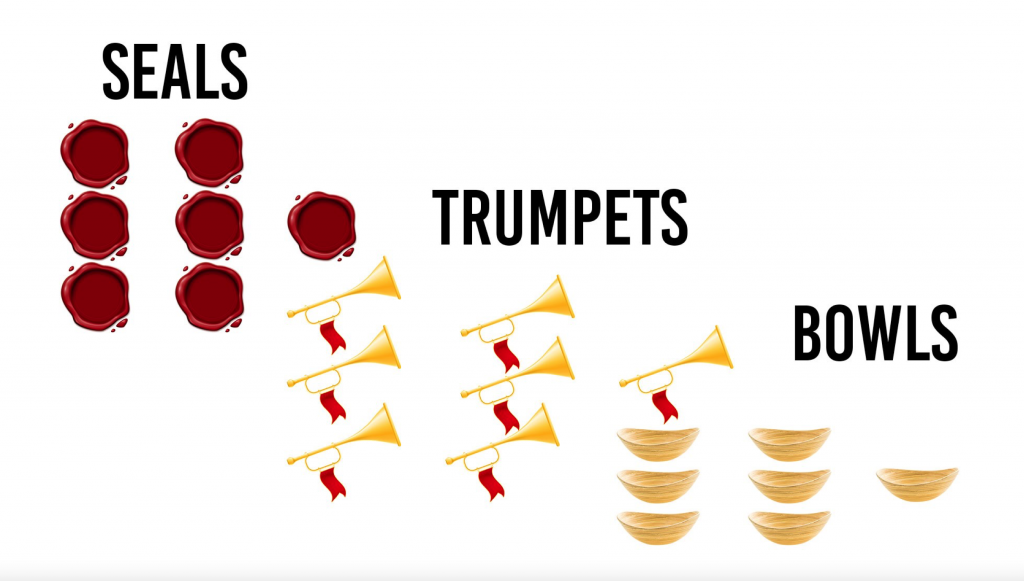
This image was taken from Google Images and was designed by Snohomish Community Church.
Others suggest that each seventh component (i.e., the seventh seal, the seventh trumpet, the seventh bowl) contains the seven that follow. Representative of this view would be Danny Akin:
Remember: the seventh seal contains the seven trumpets, and the seventh trumpet contains the seven bowls. Thus there is a sense in that the seventh seal, seventh trumpet, and the seventh bowl all bring us to the end. We might say it like this: The seventh seal brings us to “the end,” the seventh trumpet to “the very end,” and the seventh bowl to “the very, very end.”[3]
Still other interpreters put the seven seals, trumpets, and bowls in one long line of twenty-one elements and see it as a strictly chronological progression of the events of tribulation leading up to the final return of Christ.
But there is a fourth view and it is a compelling view, in my opinion. Once again, do not be dogmatic about how you view the relationship of the sevens. At the very least do not be belligerent about it! Do not dishonor the forest because of your strong views on the individual trees.
This fourth view sees a consecutive dynamic in the three sevens and a parallel dynamic. Meaning, some view the seals, trumpets, and bowls as unfolding in sequence while yet viewing the final seal, trumpet, and bowl as parallel to each other.
To understand why this view is proposed, consider two things. First, notice that there is something different about the seventh trumpet. There is a phrase used to describe God three different times leading up to our passage. Here is the phrase:
…Grace to you and peace from him who is and who was and who is to come… (Rev. 1:4)
“I am the Alpha and the Omega,” says the Lord God, “who is and who was and who is to come, the Almighty.” (Rev. 1:8)
“Holy, holy, holy, is the Lord God Almighty, who was and is and is to come!” (Rev. 4:8)
But see if you can spot the difference in Revelation 11:17 when that phrase is used in connection with the seventh trumpet:
“We give thanks to you, Lord God Almighty, who is and who was, for you have taken your great power and begun to reign.” (Rev. 11:17)
Did you catch that? What is missing? What is missing are the words “and is to come.” New Testament scholar Robert Gundry considers it “significant” that “the phrase ‘is to come’ is missing in the ascription to the Lord (v. 17).”[4] I agree.
Why is “is to come” missing? The answer seems clear enough: because the seventh trumpet depicts the second coming of Christ. He is not “is to come” in the seventh trumpet because He has just come! The seventh trumpet is therefore a picture of the second coming of Jesus, His final coming in triumph and glory!
But how can that be if we have yet to even unpack the seven bowls? How can Christ’s second coming come before all of the sevens leading up to the end are depicted?
This leads us to our second consideration, the second thing we must notice. We can get at this by taking the seventh element from the three sets of seven and putting them side by side: the seventh seal, the seventh trumpet, and the seventh bowl. Look at what happens when we do this. Listen closely to the description of each seven:
Seventh Seal
“Then the angel took the censer and filled it with fire from the altar and threw it on the earth, and there were peals of thunder, rumblings, flashes of lightning, and an earthquake.” (Rev. 8:5)
Seventh Trumpet
“Then God’s temple in heaven was opened, and the ark of his covenant was seen within his temple. There were flashes of lightning, rumblings, peals of thunder, an earthquake, and heavy hail.” (Rev. 11:19)
Seventh Bowl
And there were flashes of lightning, rumblings, peals of thunder, and a great earthquake such as there had never been since man was on the earth, so great was that earthquake. (Revelation 16:18)
What do you see there? You see parallelism and repetition. Each seventh component of the three sevens contains:
- peals of thunder
- flashes of lightning
- rumblings
- an earthquake
Why would this be? It would be, I would propose, because the seventh element of each—the seventh seal, the seventh trumpet, and the seventh bowl—are all describing the same phenomenon: the final second coming of Jesus! Dale Ralph Ellis writes:
Surely, this recurrence of such similar phenomena cannot be accidental. Moreover, in each of these cases there is a connection with the heavenly altar or temple in the context.[5]
So let us put all of this together:
- The seventh trumpet is a clear depiction of the second coming of Jesus (i.e., there is no “who is to come”).
- The seventh trumpet parallels in its language and imagery both the seventh seal before it and the seventh bowl to come.
- The seventh elements are therefore parallel ways of saying the same thing about the same event.
- The event that each seventh element points us to the second coming of Jesus!
It is therefore quite possible that the first six elements of the three sevens—seals 1-6, trumpets 1-6, bowls 1-6—should be seen as the consecutive unfolding of the events of tribulation but that each set of seven concludes by pointing us to the final return and victory of Jesus Christ. Therefore, we have both a consecutive component and a parallel component.
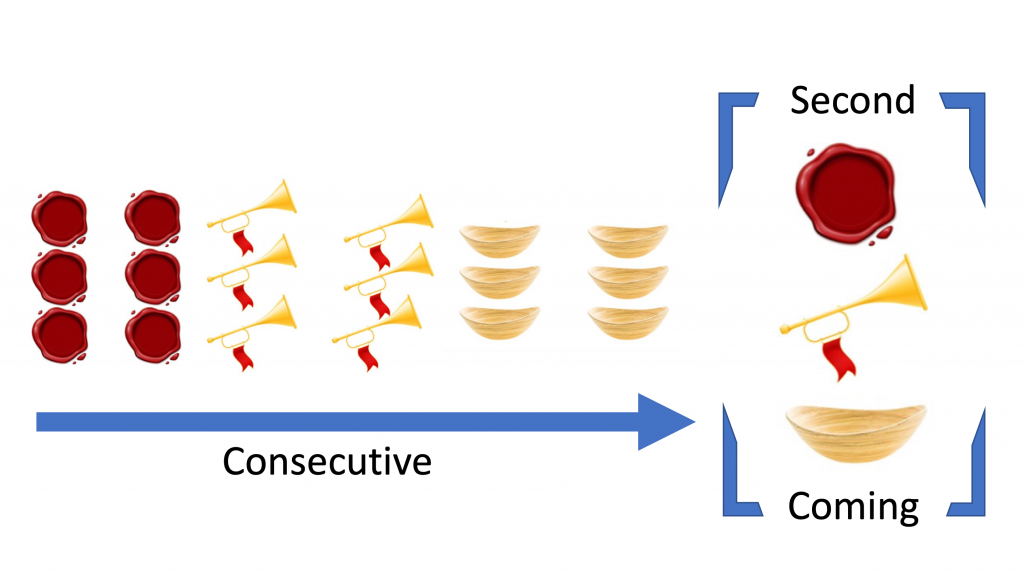
This image was found on Google Images and was modified by Wyman Richardson from an original image designed by Snohomish Community Church.
Are the sevens unfolding in a linear way or are they saying the same thing? The answer would be “Yes!”
Why would this be? Why would the initial six of each set of seven inevitably jump to the final victory of Jesus at the conclusion of their presentation?
For one simple reason: the people of God need to be consistently and repeatedly and clearly given hope! We are not meant to dwell in darkness overly long. We must not lose sight of the light!
Put another way, the Lord God is not going to make us slog through twenty-one depictions of judgment and suffering and persecution spanning multiple chapters only to remind us at the very end, “Oh yeah! Then Jesus wins! Then Jesus is victorious!” We would lose hope in such an arrangement! Our hearts would break before we reached hope!
Dale Ralph Ellis wisely writes:
It might then be asked: what possible motive could there be for John’s coming to a particular point in a judgment series and then—at the last member of that series—projecting ahead to the immediate precursor of the parousia? There is rationale for such an arrangement—both theological and practical. We cannot forget that the last days described by John meant the darkest of all times for the church. John’s intent is to never permit the Lord’s people to [permit] their gaze to drift from the invigorating Centre of their hope—their returning Lord Jesus (I Peter 1:13). Therefore, through all the judgments upon evil and through all the sufferings of the church, the Spirit seeks to chain our vision afresh to the One who brings the final vindication, so that from that vision may come a new influx of divine power to endure. Again and again John brings this certainty before us. If once this vision is firmly caught, then even we ourselves can stand before any tribunal or be stretched under any sword and yet confess: “Jesus is still Lord!”[6]
Hope! Hope! The church must not lose hope. The church must not despair!
In 1 Peter 1, Peter writes:
3 Blessed be the God and Father of our Lord Jesus Christ! According to his great mercy, he has caused us to be born again to a living hope through the resurrection of Jesus Christ from the dead
The Lord in His mercy builds a powerful image of this “living hope” to which we have been born again into each of the three depictions of increasing tribulation.
It is as if He is saying, “Yes, the broken seals reveal coming calamity and woe, but see here: Jesus wins! Yes, the trumpet blasts reveal frightening pictures of judgment and persecution, but see here: Jesus wins! Yes, the bowls are terrifying when they are poured out, but see here: Jesus wins!”
In so many ways the verse we most need to hear in this regard is verse 15:
15 Then the seventh angel blew his trumpet, and there were loud voices in heaven, saying, “The kingdom of the world has become the kingdom of our Lord and of his Christ, and he shall reign forever and ever.”
I love this! “He shall reign forever and ever!” And I love that this was said by “loud voices in heaven”!
“He shall reign forever and ever!”
“He shall reign forever and ever!”
“HE SHALL REIGN FOREVER AND EVER!!!”
So powerful and so inspiring are these words and this vision of the victory of Christ that in 1741 it moved a musician named Handel to write a chorus in his great piece “Messiah” that some call the greatest four minutes of music ever written. The writing of this chorus, “The Hallelujah Chorus” deeply affected Handel, as this history recounts:
Handel composed Messiah without getting much sleep or even eating much food. When his assistants brought him his meals, they were often left uneaten. His servants would often find him in tears as he composed. When he completed “Hallelujah,” he reportedly told his servant, “I did think I did see all Heaven before me, and the great God Himself seated on His throne, with His company of Angels.”[7]
You can feel the hope and joy just in reading the words of this chorus, though this pales, of course, in comparison to hearing it performed.
Hallelujah! Hallelujah! Hallelujah! Hallelujah! Hallelujah!
Hallelujah! Hallelujah! Hallelujah! Hallelujah! Hallelujah!
For the Lord God Omnipotent reigneth
Hallelujah! Hallelujah! Hallelujah! Hallelujah!
For the Lord God omnipotent reigneth
Hallelujah! Hallelujah! Hallelujah! Hallelujah!
Hallelujah! Hallelujah! Hallelujah! Hallelujah! Hallelujah!
Hallelujah! Hallelujah! Hallelujah! Hallelujah! Hallelujah!
Hallelujah! Hallelujah! Hallelujah! Hallelujah! Hallelujah!
The kingdom of this world
Is become the kingdom of our Lord
And of His Christ, and of His Christ
And He shall reign for ever and ever
And He shall reign for ever and ever
And He shall reign for ever and ever
For ever and ever, forever and ever
King of kings (Forever and ever Hallelujah! Hallelujah!)
And Lord of lords (Forever and ever Hallelujah! Hallelujah!)
King of kings (Forever and ever Hallelujah! Hallelujah!)
And Lord of lords (Forever and ever Hallelujah! Hallelujah!)
King of kings (Forever and ever Hallelujah! Hallelujah!)
And Lord of lords (King of kings and Lord of lords)
And He shall reign
And He shall reign
And He shall reign forever and ever
King of kings (Forever and ever)
And He shall reign (Hallelujah! Hallelujah!)
And He shall reign forever and ever
King of kings! and Lord of lords!
King of kings! and Lord of lords!
And He shall reign forever and ever
Forever and ever
Forever and ever
Hallelujah! Hallelujah!
Hallelujah! Hallelujah!
Hallelujah!
No, we cannot live without hope…and may we thank God that we do not have to! Hear the blowing of the seventh trumpet and see the coming of the Lamb in glory!
And He shall reign forever and ever!
[1] https://reasonandmeaning.com/2017/02/16/kazantzakis-epitaph-rejecting-hope/
[2] Kazantzakis, Nikos (2012-09-04). Saint Francis (Kindle Location 51). Simon & Schuster. Kindle Edition.
[3] Daniel L. Akin, Exalting Jesus in Revelation (Christ-Centered Exposition Commentary) (p. 229). B&H Publishing Group. Kindle Edition.
[4] Gundry, Robert Horton . Church and the Tribulation . Zondervan Academic. Kindle Edition.
[5] Dale Ralph Ellis. “The Relationship Between the Seals, Trumpets, and Bowls in the Book of Revelation.” Journal of the Evangelical Theological Society. (January 1, 1973), p.158.
[6] Dale Ralph Ellis, p.158.
[7] https://www.thetabernaclechoir.org/articles/history-of-handels-hallelujah-chorus.html

Wym, thank you………. how utterly encouraging can it get and how close to telling it plain can one coal biting USC sports geek get to REALITY. Great job on that text.
Pass a chuck of coal and I’ll bite it but could we let it cool off first?……… come to think of it fresh coals is way, way too soft, can we get a chunk outta the coal bin……hah!!!!!!, thought of one coal miners daughter back ’69 back ‘er in butchers holler. Thank you, thank you, THANK YOU!!!!!!!!!!!! whew!!!! hew, go Wym